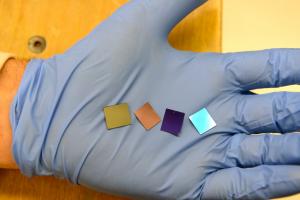
Stanford University scientists have created the thinnest, most efficient absorber of visible light on record.
The nanosized structure, thousands of times thinner than an ordinary sheet of paper, could lower the cost and improve the efficiency of solar cells, according to the scientists. Their results are published in the current online edition of the journal Nano Letters.
“Achieving complete absorption of visible light with a minimal amount of material is highly desirable for many applications, including solar energy conversion to fuel and electricity,” said Stacey Bent, a professor of chemical engineering at Stanford and co-author of the study. “Our results show that it is possible for an extremely thin layer of material to absorb almost 100 percent of incident light of a specific wavelength.”
Thinner solar cells require less material and therefore cost less. The challenge for researchers is to reduce the thickness of the cell without compromising its ability to absorb and convert sunlight into clean energy.
For the study, the Stanford team created thin wafers dotted with trillions of round particles of gold. Each gold nanodot was about 14 nanometers tall and 17 nanometers wide.
Visible spectrum
An ideal solar cell would be able to absorb the entire visible light spectrum, from violet light waves 400 nanometers long to red waves 700 nanometers in length, as well as invisible ultraviolet and infrared light. In the experiment,Hagglund and his colleagues were able to tune the gold nanodots to absorb only visible, reddish-orange light waves about 600 nanometers long.
“Much like a guitar string, which has a resonance frequency that changes when you tune it, metal particles have a resonance frequency that can be fine-tuned to absorb a particular wavelength of light,” said postdoctoral scholar CarlHagglund, lead author of the study. “We tuned the optical properties of our system to maximize the light absorption.”
The gold nanodot-filled wafers were fabricated at a nearby Hitachi facility using a technique called block-copolymer lithography. Each wafer contained about 520 billion nanodots per square inch. Under the microscope, the hexagonal array of particles was reminiscent of a honeycomb.
Hagglund’s team added a thin-film coating on top of the wafers using a process called atomic layer deposition. “It’s a very attractive technique, because you can coat the particles uniformly and control the thickness of the film down to the atomic level, “ he said. “That allowed us to tune the system simply by changing the thickness of the coating around the dots. People have built arrays like this, but they haven’t tuned them to the optimal conditions for light absorption. That’s one novel aspect of our work.”
Record results
The results were record setting. “The coated wafers absorbed 99 percent of the reddish-orange light,” Hagglund said. “We also achieved 93 percent absorption in the gold nanodots themselves. The volume of each dot is equivalent to a layer of gold just 1.6 nanometers thick, making it the thinnest absorber of visible light on record – about 1,000 times thinner than commercially available thin film solar cell absorbers.”
The previous record-holder required an absorber layer three times thicker to reach total light absorption, he added. “So we’ve substantially pushed the limits of what can be achieved for light harvesting by optimizing these ultrathin, nanoengineered systems,” Hagglund said.
Solar cell applications
The next step for the Stanford team is to demonstrate that visible light waves can actually be converted into useful forms of energy. “We are now looking at building structures using ultrathin semiconductor materials that can absorb sunlight,” said Bent, co-director of the Stanford Center on Nanostructuring for Efficient Energy Conversion (CNEEC). “These prototypes will then be tested to see how efficiently we can achieve solar energy conversion.”
The Latest Bing News on:
Light-absorber
- This highly reflective black paint makes objects more visible to autonomous carson May 1, 2024 at 3:17 pm
Self-driving cars could soon become better night drivers thanks to a new, highly reflective black paint that’s easily detectable by lidar sensors, as described in ACS Applied Materials & Interfaces.
- UV Light Stabilizers Market Growth Analysis, Size, Prominent Players, Overview, and Forecast to 2024 to 2032on April 28, 2024 at 3:41 pm
UV light stabilizers protect plastic or wooden components from long-term effects of ultraviolet radiations. A polymer photo-degradation process occurs when a substance is exposed to UV radiation, ...
- The 13 Best Light Therapy Devices to Clear Your Skinon April 25, 2024 at 4:00 pm
“This particular species produces a substance called porphyrin that will absorb the blue light and, through a chemical reaction, can destroy the bacteria. In the era of increasing antibiotic ...
- The 13 Best Light Therapy Devices to Clear Your Skinon April 24, 2024 at 5:00 pm
“This particular species produces a substance called porphyrin that will absorb the blue light and, through a chemical reaction, can destroy the bacteria. In the era of increasing antibiotic ...
- Top 5 Best Shock Absorbers 2024on April 24, 2024 at 5:00 pm
Shock absorbers are vital components in a vehicle’s suspension system, specifically designed to reduce the bumps and jolts experienced while traversing uneven terrains or obstacles. A highly ...
- How light can vaporize water without the need for heaton April 23, 2024 at 5:00 pm
None of these varying characteristics should happen because at these wavelengths, water hardly absorbs light at all -- and yet the researchers observed them. The effect is strongest when light ...
- Infrared photovoltaics made by solution processingon April 23, 2024 at 5:00 pm
Solution-processed materials, where the active light absorber is dispersed in a solvent that evaporates during the photovoltaic manufacturing process, offer particular promise with respect to cost ...
- How light can vaporize water without the need for heaton April 23, 2024 at 12:56 pm
It's the most fundamental of processes—the evaporation of water from the surfaces of oceans and lakes, the burning off of fog in the morning sun, and the drying of briny ponds that leaves solid salt ...
- Wearing these light clothes in summer will provide relief, sweat and stickiness will also go awayon April 21, 2024 at 11:10 pm
In scorching summer heat, finding relief becomes paramount. Light clothes offer a simple yet effective solution to beat the heat. Let's ..|News Track ...
- Alien Life May Not Be the Color We Know Iton April 17, 2024 at 10:49 am
On earth, plants get their green color from chlorophyll pigments in their leaves. Chlorophyll absorbs light to power the process of photosynthesis, which is how plants make their own food.
The Latest Google Headlines on:
Light-absorber
[google_news title=”” keyword=”light-absorber” num_posts=”10″ blurb_length=”0″ show_thumb=”left”]
The Latest Bing News on:
Lght harvesting
- China seeks to harvest user data from global apps to boost propaganda effortson May 1, 2024 at 5:09 pm
In the global discussion around data privacy and security, much attention has been rightfully placed on the Chinese-owned platform TikTok, with concerns that the user data it collects is accessible to ...
- How to harvest a Cooling Herb in Disney Dreamlight Valleyon May 1, 2024 at 12:58 pm
To earn exciting rewards in Disney Dreamlight Valley from the “A Day at Disney” Star Path, you’ll need to complete Star Path Duties to earn Mickey Mouse Tokens. One of these asks you to “Harvest a ...
- govi.ai captures industry attention at Future Harvest Expo 2024on May 1, 2024 at 12:30 pm
govi.ai, a leading innovator in agricultural IoT solutions, presented a programme at the recent Future Harvest Exhibition held at the Bandaranayake Memorial International Conference Hall (BMICH) from ...
- 5 Reasons to Eat More Mushroomson April 30, 2024 at 12:05 pm
Science-backed health benefits. — Sustainably grown. — Tasty, versatile ingredient. When exposed to ultraviolet light, mushrooms become a good source of vitamin D, turning into one of the few vegan ...
- New short film, "Harvest Calls" shows local musician turning the sounds of wine harvest into albumon April 29, 2024 at 4:42 pm
The film “Harvest Calls” chronicles Brook Munro's journey to create his album “Harvest in Twelve Parts." The album blends rich instrumentation with natural harvest sounds, like grapes being juiced and ...
- How to Harvest Rosemary for Its Fragrant Leaveson April 29, 2024 at 1:34 pm
When to Harvest Rosemary. Rosemary can be harvested little by little or it can be gathered in larger quantities for freezing or drying. Many growers harvest rosemary stems when pr ...
- The first asparagus spears emerge in April. Harvest them with a knife or snap off by handon April 23, 2024 at 8:04 am
The first asparagus spears emerge in April. To harvest, you may cut them with a knife or use your fingers to snap them off at the base of the spear.
- Silicon Labs unveils wireless SoCs for energy harvestingon April 23, 2024 at 7:40 am
Silicon Labs introduces its first and most energy-efficient wireless SoCs for developing energy-harvesting devices.
- Silicon Labs Streamlines Energy Harvesting Product Development For Battery-Free Ioton April 22, 2024 at 11:25 am
Hyderabad, Telangana, India Silicon Labs (NASDAQ: SLAB), a leader in secure, intelligent wireless technology for a more connected world, to ...
- The winners and finalists of the 2024 Arkansas Times Cannabis Awardson April 19, 2024 at 5:00 am
Our readers cast their votes on the best of the best in the Arkansas cannabis world — tinctures, topicals, terpenes and everything in between.
The Latest Google Headlines on:
Light harvesting
[google_news title=”” keyword=”light harvesting” num_posts=”10″ blurb_length=”0″ show_thumb=”left”]











